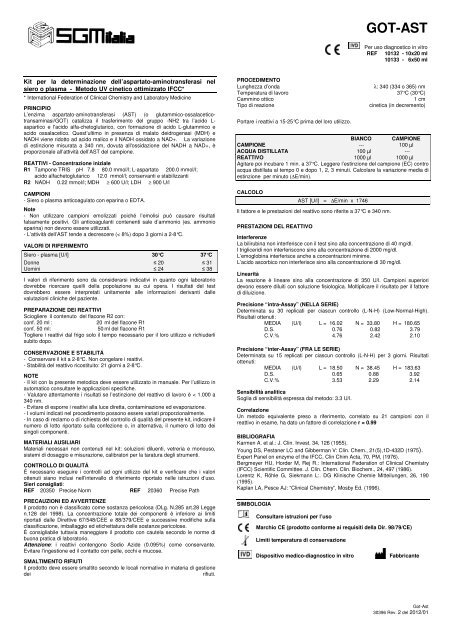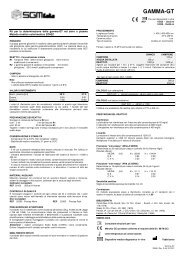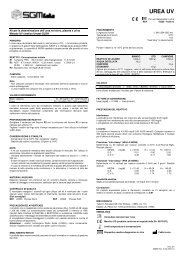GOT-AST - Sgmitalia.com
GOT-AST - Sgmitalia.com
GOT-AST - Sgmitalia.com
Create successful ePaper yourself
Turn your PDF publications into a flip-book with our unique Google optimized e-Paper software.
Kit per la determinazione dell’aspartato-aminotransferasi nel<br />
siero o plasma - Metodo UV cinetico ottimizzato IFCC*<br />
* International Federation of Clinical Chemistry and Laboratory Medicine<br />
PRINCIPIO<br />
L’enzima aspartato-aminotransferasi (<strong>AST</strong>) (o glutammico-ossalaceticotransaminasi/<strong>GOT</strong>)<br />
catalizza il trasferimento del gruppo -NH2 tra l’acido Laspartico<br />
e l'acido alfa-chetoglutarico, con formazione di acido L-glutammico e<br />
acido ossalacetico. Quest’ultimo in presenza di malato deidrogenasi (MDH) e<br />
NADH viene ridotto ad acido malico e il NADH ossidato a NAD+. La variazione<br />
di estinzione misurata a 340 nm, dovuta all'ossidazione del NADH a NAD+, è<br />
proporzionale all’attività dell’<strong>AST</strong> del campione.<br />
REATTIVI - Concentrazione iniziale<br />
R1 Tampone TRIS pH 7.8 80.0 mmol/l; L-aspartato 200.0 mmol/l;<br />
acido alfachetoglutarico 12.0 mmol/l; conservanti e stabilizzanti<br />
R2 NADH 0.22 mmol/l; MDH ≥ 600 U/l; LDH ≥ 900 U/l<br />
CAMPIONI<br />
- Siero o plasma anticoagulato con eparina o EDTA.<br />
Note<br />
- Non utilizzare campioni emolizzati poiché l’emolisi può causare risultati<br />
falsamente positivi. Gli anticoagulanti contenenti sale d’ammonio (es. ammonio<br />
eparina) non devono essere utilizzati.<br />
- L’attività dell’<strong>AST</strong> tende a decrescere (< 8%) dopo 3 giorni a 2-8°C.<br />
VALORI DI RIFERIMENTO<br />
Siero - plasma [U/l] 30°C 37°C<br />
Donne ≤ 20 ≤ 31<br />
Uomini ≤ 24 ≤ 38<br />
I valori di riferimento sono da considerarsi indicativi in quanto ogni laboratorio<br />
dovrebbe ricercare quelli della popolazione su cui opera. I risultati del test<br />
dovrebbero essere interpretati unitamente alle informazioni derivanti dalle<br />
valutazioni cliniche del paziente.<br />
PREPARAZIONE DEI REATTIVI<br />
Sciogliere il contenuto del flacone R2 con:<br />
conf. 20 ml : 20 ml del flacone R1<br />
conf. 50 ml: 50 ml del flacone R1<br />
Togliere i reattivi dal frigo solo il tempo necessario per il loro utilizzo e richiuderli<br />
subito dopo.<br />
CONSERVAZIONE E STABILITÁ<br />
- Conservare il kit a 2-8°C. Non congelare i reattivi.<br />
- Stabilità del reattivo ricostituito: 21 giorni a 2-8°C.<br />
NOTE<br />
- Il kit con la presente metodica deve essere utilizzato in manuale. Per l’utilizzo in<br />
automatico consultare le applicazioni specifiche.<br />
- Valutare attentamente i risultati se l’estinzione del reattivo di lavoro è < 1.000 a<br />
340 nm.<br />
- Evitare di esporre i reattivi alla luce diretta, contaminazione ed evaporazione.<br />
- I volumi indicati nel procedimento possono essere variati proporzionalmente.<br />
- In caso di reclamo o di richiesta del controllo di qualità del presente kit, indicare il<br />
numero di lotto riportato sulla confezione o, in alternativa, il numero di lotto dei<br />
singoli <strong>com</strong>ponenti.<br />
MATERIALI AUSILIARI<br />
Materiali necessari non contenuti nel kit: soluzioni diluenti, vetreria e monouso,<br />
sistemi di dosaggio e misurazione, calibratori per la taratura degli strumenti.<br />
CONTROLLO DI QUALITÁ<br />
É necessario eseguire i controlli ad ogni utilizzo del kit e verificare che i valori<br />
ottenuti siano inclusi nell’intervallo di riferimento riportato nelle istruzioni d’uso.<br />
Sieri consigliati:<br />
REF 20350 Precise Norm REF 20360 Precise Path<br />
PRECAUZIONI ED AVVERTENZE<br />
Il prodotto non è classificato <strong>com</strong>e sostanza pericolosa (DLg. N.285 art.28 Legge<br />
n.128 del 1998). La concentrazione totale dei <strong>com</strong>ponenti è inferiore ai limiti<br />
riportati dalle Direttive 67/548/CEE e 88/379/CEE e successive modifiche sulla<br />
classificazione, imballaggio ed etichettatura delle sostanze pericolose.<br />
É consigliabile tuttavia maneggiare il prodotto con cautela secondo le norme di<br />
buona pratica di laboratorio.<br />
Attenzione: i reattivi contengono Sodio Azide (0.095%) <strong>com</strong>e conservante.<br />
Evitare l’ingestione ed il contatto con pelle, occhi e mucose.<br />
SMALTIMENTO RIFIUTI<br />
Il prodotto deve essere smaltito secondo le locali normative in materia di gestione<br />
dei rifiuti.<br />
<strong>GOT</strong>-<strong>AST</strong><br />
Per uso diagnostico in vitro<br />
REF 10132 - 10x20 ml<br />
10133 - 6x50 ml<br />
PROCEDIMENTO<br />
Lunghezza d’onda λ: 340 (334 o 365) nm<br />
Temperatura di lavoro 37°C (30°C)<br />
Cammino ottico 1 cm<br />
Tipo di reazione cinetica (in decremento)<br />
Portare i reattivi a 15-25°C prima del loro utilizzo.<br />
BIANCO CAMPIONE<br />
CAMPIONE --- 100 µl<br />
ACQUA DISTILLATA 100 µl ---<br />
REATTIVO 1000 µl 1000 µl<br />
Agitare poi incubare 1 min. a 37°C. Leggere l’estinzione del campione (EC) contro<br />
acqua distillata al tempo 0 e dopo 1, 2, 3 minuti. Calcolare la variazione media di<br />
estinzione per minuto (∆E/min).<br />
CALCOLO<br />
<strong>AST</strong> [U/l] = ∆E/min x 1746<br />
Il fattore e le prestazioni del reattivo sono riferite a 37°C e 340 nm.<br />
PRESTAZIONI DEL REATTIVO<br />
Interferenze<br />
La bilirubina non interferisce con il test sino alla concentrazione di 40 mg/dl.<br />
I trigliceridi non interferiscono sino alla concentrazione di 2000 mg/dl.<br />
L’emoglobina interferisce anche a concentrazioni minime.<br />
L’acido ascorbico non interferisce sino alla concentrazione di 30 mg/dl.<br />
Linearità<br />
La reazione è lineare sino alla concentrazione di 350 U/l. Campioni superiori<br />
devono essere diluiti con soluzione fisiologica. Moltiplicare il risultato per il fattore<br />
di diluizione.<br />
Precisione “intra-Assay” (NELLA SERIE)<br />
Determinata su 30 replicati per ciascun controllo (L-N-H) (Low-Normal-High).<br />
Risultati ottenuti:<br />
MEDIA (U/l) L = 16.02 N = 33.80 H = 180.65<br />
D.S. 0.76 0.82 3.79<br />
C.V.% 4.76 2.42 2.10<br />
Precisione “inter-Assay” (FRA LE SERIE)<br />
Determinata su 15 replicati per ciascun controllo (L-N-H) per 3 giorni. Risultati<br />
ottenuti:<br />
MEDIA (U/l) L = 18.50 N = 38.45 H = 183.63<br />
D.S. 0.65 0.88 3.92<br />
C.V.% 3.53 2.29 2.14<br />
Sensibilità analitica<br />
Soglia di sensibilità espressa dal metodo: 3.3 U/l.<br />
Correlazione<br />
Un metodo equivalente preso a riferimento, correlato su 21 campioni con il<br />
reattivo in esame, ha dato un fattore di correlazione r = 0.99<br />
BIBLIOGRAFIA<br />
Karmen A. et al.: J. Clin. Invest. 34, 126 (1955).<br />
Young DS, Pestaner LC and Gibberman V: Clin. Chem., 21(5),1D-432D (1975).<br />
Expert Panel on enzyme of the IFCC, Clin Chim Acta, 70, PM, (1976).<br />
Bergmeyer HU, Horder M, Rej R.: International Federation of Clinical Chemistry<br />
(IFCC) Scientific Committee. J. Clin. Chem. Clin. Biochem., 24, 497 (1986).<br />
Lorentz K, Röhle G, Siekmann L:. DG Klinische Chemie Mitteilungen, 26, 190<br />
(1995).<br />
Kaplan LA, Pesce AJ: “Clinical Chemistry”, Mosby Ed. (1996).<br />
SIMBOLOGIA<br />
Consultare istruzioni per l’uso<br />
Marchio CE (prodotto conforme ai requisiti della Dir. 98/79/CE)<br />
Limiti temperatura di conservazione<br />
Dispositivo medico-diagnostico in vitro Fabbricante<br />
Got-Ast<br />
30396 Rev. 2 del 2012/01
Kit for measurement of aspartate-aminotransferase in serum or<br />
plasma - Kinetic UV optimized method IFCC*<br />
* International Federation of Clinical Chemistry and Laboratory Medicine<br />
PRINCIPLE<br />
The enzyme aspartate-aminotransferase (<strong>AST</strong>) (or glutamic-oxaloacetic<br />
transaminase/<strong>GOT</strong>) catalyzes reaction between alpha-ketoglutarate and Laspartate<br />
giving glutamate and oxaloacetate. In presence of malate<br />
dehydrogenase (MDH), oxaloacetate reacts with NADH giving malate and NAD+.<br />
The change of absorbance measured at 340 nm is proportional to the <strong>AST</strong> activity<br />
of the sample.<br />
REAGENTS<br />
R1 TRIS buffer pH 7.8 80.0 mmol/l; L-aspartate 200.0 mmol/l;<br />
alpha-ketoglutarate acid 12.0 mmol/l; preservatives and stabilizers<br />
R2 NADH 0.22 mmol/l ; MDH ≥ 600 U/l; LDH ≥ 900 U/l<br />
SAMPLE<br />
- Serum-heparinized plasma or EDTA plasma.<br />
Note<br />
- Do not use samples with haemolysis because this one could cause results<br />
wrongly positive. The anticoagulants containing ammonium salt (es. ammonium<br />
heparinate) mustn’t be used.<br />
- The <strong>AST</strong> activity tends to decrease (< 8%) after 3 days at 2-8°C.<br />
REFERENCE VALUES<br />
Serum - plasma [U/l] 30°C 37°C<br />
Women ≤ 20 ≤ 31<br />
Men ≤ 24 ≤ 38<br />
References values are considered indicatives since each laboratory should<br />
establish references ranges for its own patient’s population. The analytical results<br />
should be evaluated with other information <strong>com</strong>ing from patient’s clinical story.<br />
PREPARATION OF REAGENTS<br />
Dissolve the content of R2 vial with:<br />
vial 20 ml: 20 ml of R1 solution<br />
vial 50 ml: 50 ml of R1 solution<br />
Keep out the reagents from refrigerator only for the use and recap them<br />
immediately.<br />
STORAGE AND STABILITY<br />
- Store the kit at 2-8°C. Do not freeze the reagents.<br />
- Reconstituted reagent stability: 21 days at 2-8°C.<br />
NOTE<br />
- The kit, according to this method, must be used in manual procedures. About<br />
automatic using follow specific applications.<br />
- Evaluate carefully the results if working reagent absorbance is < 1.000 at<br />
340 nm.<br />
- Avoid direct light, contamination and evaporation.<br />
- The volumes in the procedure can be changed proportionally.<br />
- In case of <strong>com</strong>plaint or quality control request, refer to the lot number on the<br />
package or the lot number on the singles vials.<br />
AUXILIARY EQUIPMENT<br />
Materials not included in the kit: diluent solutions, laboratory glassware,<br />
disposable tips, photometers and calibrators.<br />
QUALITY CONTROLS<br />
It’s necessary, every time the kit is used, to make the quality controls and to check<br />
that values obtained are within the acceptance range provided in the insert.<br />
Suggested serum:<br />
REF 20350 Precise Norm REF 20360 Precise Path<br />
PRECAUTION IN USE<br />
The product is not classified as dangerous (DLg. N. 285 art. 28 l. n. 128/1998).<br />
The total concentration of <strong>com</strong>ponents is lower than the limits reported by 67/548<br />
and 88/379 CE Regulations (and following modifications) about classification,<br />
packaging and labelling of dangerous substances.<br />
However the reagent should be handled with caution, according to good laboratory<br />
practice.<br />
Caution: the reagents contain Sodium Azide (0.095%) as preservative. Avoid<br />
swallowing and contacting with skin, eyes and mucous membranes.<br />
W<strong>AST</strong>E MANAGEMENT<br />
Please refer to the local legal requirements.<br />
<strong>GOT</strong>-<strong>AST</strong><br />
For in vitro medical device<br />
REF 10132 - 10x20 ml<br />
10133 - 6x50 ml<br />
PROCEDURES<br />
Wavelength λ: 340 (334 o 365) nm<br />
Working temperature 37°C (30°C)<br />
Optical path 1 cm<br />
Reaction kinetic (decreasing)<br />
Bring the reagents at 15-25°C before using them.<br />
BLANK SAMPLE<br />
SAMPLE --- 100 µl<br />
DISTILLED WATER 100 µl ---<br />
REAGENT 1000 µl 1000 µl<br />
Mix, then incubate for 1’ a 37°C. Measure the absorbance of sample (EC) against<br />
distilled water every minute during 3 minutes. Calculate the average absorbance<br />
difference per minute (∆E/min).<br />
CALCULATION<br />
<strong>AST</strong> [U/l] = ∆E/min x 1746<br />
The factor and the reagent performances are related to 37°C and 340 nm.<br />
ANALYTICAL PERFORMANCES<br />
Interferences<br />
Bilirubin does not interfere up to concentration of 40 mg/dl.<br />
Triglycerides do not interfere up to concentration of 2000 mg/dl.<br />
Hemoglobin interferes also at minimum concentrations.<br />
Ascorbate acid does not interfere up to concentration of 30 mg/dl.<br />
Linearity<br />
Reaction is linear up to a concentration of 350 U/l. Samples with values exceeding<br />
this range must be diluted with saline solution. Multiply, then, the result for diluting<br />
factor.<br />
“Intra-Assay” precision (within-Run)<br />
Determined on 30 samples for each control (L-N-H) (Low-Normal-High).<br />
Results:<br />
MEAN (U/l) L = 16.02 N = 33.80 H = 180.65<br />
S.D. 0.76 0.82 3.79<br />
C.V.% 4.76 2.42 2.10<br />
“Inter-Assay” precision (between-run)<br />
Determined on 15 samples for each control (L-N-H) for 3 days.<br />
Results:<br />
MEAN (U/l) L = 18.50 N = 38.45 H = 183.63<br />
S.D. 0.65 0.88 3.92<br />
C.V.% 3.53 2.29 2.14<br />
Analytical sensitivity<br />
The test sensitivity in terms of detection limit is 3.3 U/l.<br />
Correlation<br />
A study based <strong>com</strong>paring this method with a similar method on 21 samples has<br />
given a correlating factor r = 0.99<br />
BIBLIOGRAPHY<br />
Karmen A. et al.: J. Clin. Invest. 34, 126 (1955).<br />
Young DS, Pestaner LC and Gibberman V: Clin. Chem., 21(5),1D-432D (1975).<br />
Expert Panel on enzyme of the IFCC, Clin Chim Acta, 70, PM, (1976).<br />
Bergmeyer HU, Horder M, Rej R.: International Federation of Clinical Chemistry<br />
(IFCC) Scientific Committee. J. Clin. Chem. Clin. Biochem., 24, 497 (1986).<br />
Lorentz K, Röhle G, Siekmann L:. DG Klinische Chemie Mitteilungen, 26, 190<br />
(1995).<br />
Kaplan LA, Pesce AJ: “Clinical Chemistry”, Mosby Ed. (1996).<br />
SYMBOLS<br />
Read instruction for use<br />
CE mark (requirement of 98/79 regulation)<br />
Storaging temperature limits<br />
In vitro medical device Producer<br />
Got-Ast<br />
30396 Rev. 2 of 2012/01
















